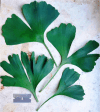Strong increase of photosynthetic pigments and leaf size in a pruned Ginkgo biloba tree
- PMID: 39651366
- PMCID: PMC11558581
- DOI: 10.32615/ps.2023.020
Strong increase of photosynthetic pigments and leaf size in a pruned Ginkgo biloba tree
Abstract
A 50-year-old solitary, sun-exposed ginkgo tree had strongly been pruned in the fall of 2021. Very few buds for the formation of new leaves, twigs, and branches were left over. In spring 2022, these few remaining buds responded with the formation of a different leaf type. These leaves were 2.7 times larger and also thicker than in the years before. In addition, the mean content of total chlorophylls [Chl (a+b)] per leaf area unit of dark-green leaves was 1.45, those of green leaves two times higher as compared to the years before pruning and the two other ginkgo trees which had been investigated in parallel. A comparable increase was also found for the level of total carotenoids (x+c). The mean content for Chl (a+b) were 1,118 mg m-2 for dark-green and 898 mg m-2 for green leaves as compared to 435 to 770 mg m-2 in leaves of other trees. The higher values for Chl (a+b) and total carotenoid content showed up also on a fresh and dry mass basis. Thus, with the formation of a new, larger leaf type by changes in morphology (leaf size and thickness) and the increase of photosynthetic pigments, the pruned ginkgo tree was able to compensate for the much lower number of leaves and photosynthetic units.
Keywords: chlorophyll a/b ratio; chlorophyll levels; leaf size; leaf thickness; ratio of chlorophylls to carotenoids; total carotenoid content.
Copyright: © 2023 Lichtenthaler et al.
Conflict of interest statement
The authors declare that they have no conflict of interest.
Figures






Similar articles
-
Chlorophyll fluorescence kinetics, photosynthetic activity, and pigment composition of blue-shade and half-shade leaves as compared to sun and shade leaves of different trees.Photosynth Res. 2013 Nov;117(1-3):355-66. doi: 10.1007/s11120-013-9834-1. Epub 2013 May 14. Photosynth Res. 2013. PMID: 23670216
-
Differences in photosynthetic activity, chlorophyll and carotenoid levels, and in chlorophyll fluorescence parameters in green sun and shade leaves of Ginkgo and Fagus.J Plant Physiol. 2007 Jul;164(7):950-5. doi: 10.1016/j.jplph.2006.09.002. Epub 2006 Oct 30. J Plant Physiol. 2007. PMID: 17074414
-
Contents of photosynthetic pigments and ratios of chlorophyll a/b and chlorophylls to carotenoids (a+b)/(x+c) in C4 plants as compared to C3 plants.Photosynthetica. 2021 Sep 16;60(1):3-9. doi: 10.32615/ps.2021.041. eCollection 2022. Photosynthetica. 2021. PMID: 39648996 Free PMC article.
-
Differences in pigment composition, photosynthetic rates and chlorophyll fluorescence images of sun and shade leaves of four tree species.Plant Physiol Biochem. 2007 Aug;45(8):577-88. doi: 10.1016/j.plaphy.2007.04.006. Epub 2007 May 1. Plant Physiol Biochem. 2007. PMID: 17587589
-
Biosynthesis, accumulation and emission of carotenoids, alpha-tocopherol, plastoquinone, and isoprene in leaves under high photosynthetic irradiance.Photosynth Res. 2007 May;92(2):163-79. doi: 10.1007/s11120-007-9204-y. Epub 2007 Jul 17. Photosynth Res. 2007. PMID: 17634750 Review.
Cited by
-
Honoring Hartmut Karl Lichtenthaler, innovative pioneer of photosynthesis, on his 90th birthday.Photosynthetica. 2024 Apr 8;62(4):326-338. doi: 10.32615/ps.2024.017. eCollection 2024. Photosynthetica. 2024. PMID: 39811710 Free PMC article.
References
-
- Cao M., Gan Q., Xu Y. et al.: Pruning improves seedling development and bioactive secondary metabolite accumulation in the leaves of Ginkgo biloba. – Trees 36: 953-966, 2022. 10.1007/s00468-021-02260-2 - DOI
-
- Eschrich W., Burchardt R., Essiamah S.: The induction of sun and shade leaves of the European beech (Fagus sylvatica L.): anatomical studies. – Trees 3: 1-10, 1989. 10.1007/BF00202394 - DOI
-
- Fujii K.: [Observation on the morphology of the pollen tube and the spermatozoid of Ginkgo biloba.] – Botan. Mag. Tokyo 13: 28-30, 1899. [In Japanese]
-
- Grochowska M.J., Karaszewska A., Jankowska B. et al.: Dormant pruning influence on auxin, gibberellin and cytokinin levels in apple trees. – J. Am. Soc. Hortic. Sci. 109: 312-318, 1984. 10.21273/JASHS.109.3.312 - DOI
LinkOut - more resources
Full Text Sources
